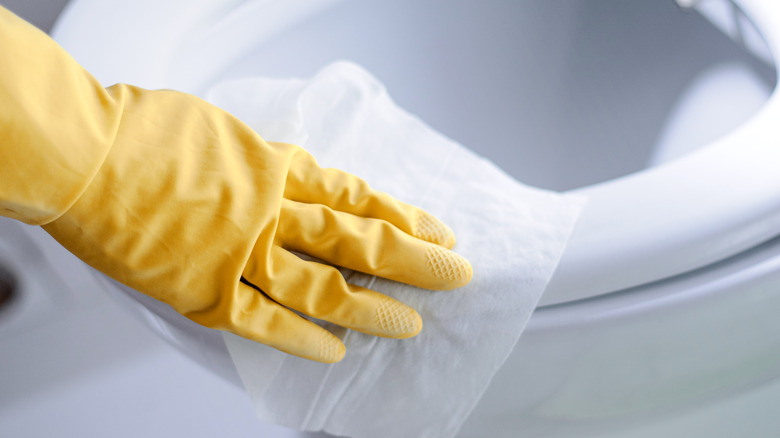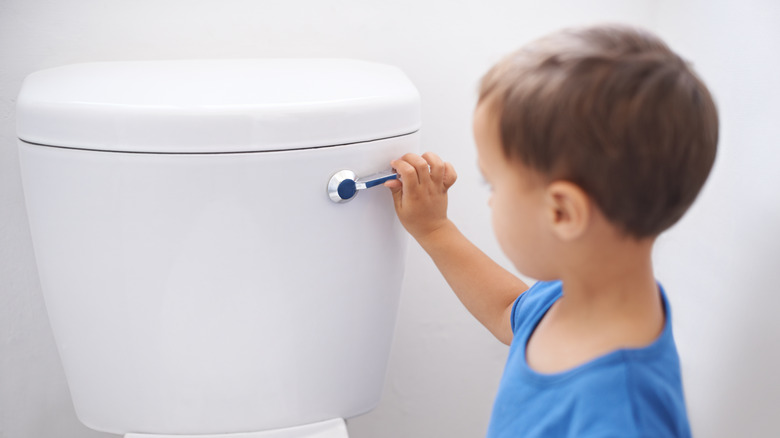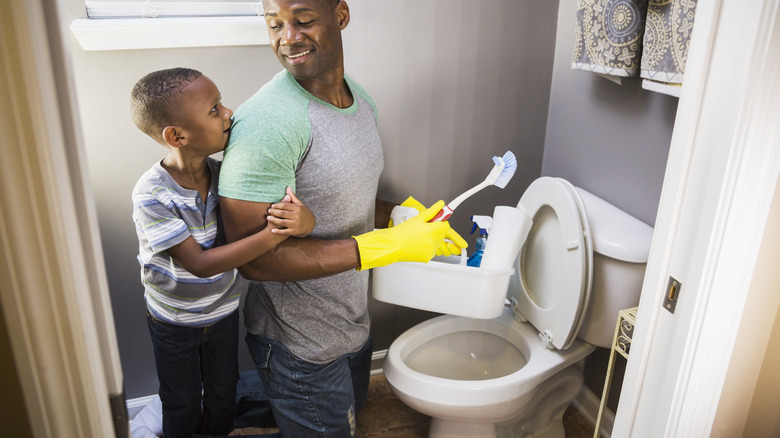Cleaning The Toilet? You May Want To Reconsider Using Disinfectant Wipes
Humans spend around 240 days out of their entire lives (at least to the age of 80) on the toilet, so it's no wonder they want to keep this porcelain throne sparkling clean between uses. Modern solutions like disinfectant wipes have made life so easy when it comes to sanitizing your toilet, but you could be leaving behind all the bacteria you thought the wipes were getting rid of in the process. You might want to think twice before you reach for that package of disinfectant towels, or at least know that to be effective, the cleaning solution needs at least four minutes of contact with your toilet, crucially while it's also still wet. If it dries, you're missing a majority of the germs you set out to eradicate.
Checking directions for cleaners like disinfectant wipes before use may feel redundant. After all, how hard can it be to pull one out and swipe it across a dirty surface like your toilet? However, it might come as a surprise to some people that you've likely been cleaning with disinfectant wipes all wrong. According to the Lysol website, for instance, to properly sanitize a surface the wipe only needs 10 seconds. But, if you're trying to disinfect, the solution from the wipes must remain on the toilet for four minutes minimum, and it should be wet throughout that time. Since most disinfectant dries quickly when exposed to air, your seat and any adjoining pieces aren't being properly disinfected, only sanitized.
Sanitizing and disinfecting are very different when it comes to your toilet
The biggest difference between sanitizing and disinfecting is that the former only targets bacteria, not viruses. Disinfecting something means you are ridding it of both, which is especially important when you consider that pathogens are released with each flush. These can lead to illnesses and other complications in the human body, so it's crucial to rid your surfaces of viruses as well as bacteria when cleaning. Fortunately, you have several options if you still want to use disinfectant wipes during your routine.
You can continuously apply the same towel, keeping the toilet covered in the disinfectant, or you can use multiple wipes to reapply the moist cleaner so that it can absorb and fight off germs for the full four minutes. Lysol even suggests opting for multiple wipes so that you can properly wet the surface you're working on, using two or more to cover the toilet. Avoid turning on vent fans or leaving windows open — anything that will dry the disinfectant faster should be turned off or closed so that the wipes can do their job.
Incorporate a multi-step process to properly clean your toilet
One of the biggest mistakes everyone makes with their toilet is simply neglecting to clean it on a weekly basis. There are plenty of methods of doing so effectively, which will help just as much as wipes, if not more. Taking the extra time to incorporate a multi-step process to disinfect and sanitize is the best way, especially since this particular appliance houses some of the largest collection of germs, bacteria, pathogens, and viruses in any home. While wipes make the process quicker and more convenient, nursery rhymes taught us that slow and steady wins for a reason. Start by using mild dish soap and warm water, scrubbing the entire toilet with a sponge or cloth reserved just for this purpose. Once you've sudsed it up thoroughly, rinse with more water to remove the soap and bubbles.
Either before or after the soap and water step, you can use a multi-purpose bathroom cleaner on the surfaces, then again inside the bowl after you've washed the exterior. Make sure to pay attention to the hinges, flush, and edges, too. Scrub the bowl with the multi-purpose cleaner and a brush, getting up along the undersides of the lip too. To fully disinfect it, you might need to opt for a product that contains bleach. After spraying the whole fixture, let the cleaner sit for several minutes on the entire toilet before wiping it with a clean cloth.


